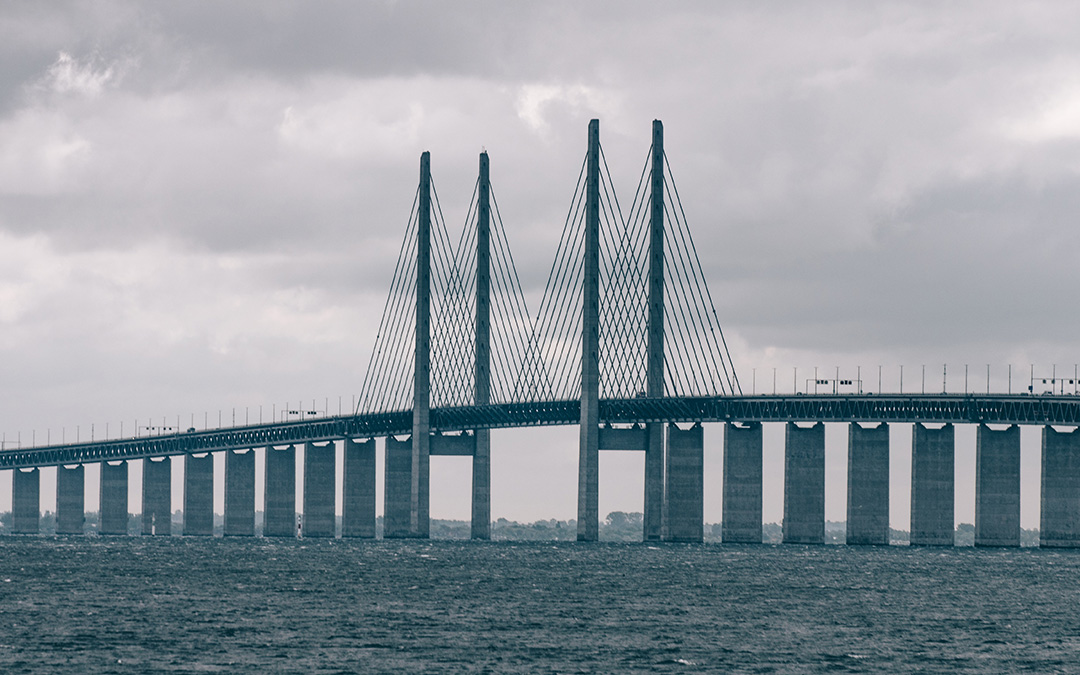The Danes trade a lot and successfully – especially with Germany, Great Britain, Sweden, Norway, France, and the Netherlands. Imports and exports account for more than half of the domestic product. To keep it that way, the country is investing generously in infrastructure.
The facts:
- Three quarters of exports are industrial goods and machinery. Danish furniture and clothing are also in demand.
- The annual domestic transport volume of trucks and ships amounts to 165 million tons, international transportbrings it to almost 100 million tons.
- The annual transport performance is approximately 15 billion ton kilometers.
- 86 percent of domestic freight traffic is carried by truck, the rest mainly by ship.
- In cross-border freight traffic, ships dominate with a share of around 64 percent of the total freight volume. Danish trucks account for around 10 percent, while foreign trucks account for around 19 percent. That leaves just under 8 percent for rail.
- More than 430,000 freight vehicles are on the roads in Denmark. The trend is slightly downward.
- Almost 5,000 companies are active in the sector and employ more than 30,000 people.
Those figures already give us an idea of what is going on: The Danish transport market is rather fragmented. About one third of the companies have only one truck. Most carriers employ fewer than ten people. There are hardly any large forwarding companies with their own vehicles. The best known is DSV, with more than 9,000 employees worldwide and 17,000 vehicles operating under the DSV flag.
Consistent controls and high penalties
Denmark is one of the few EU countries in which the 25.25-meter gigaliners are rolling – and have been since 2008. Denmark also controls cabotage regulations more consistently than other countries. Every truck is recorded by cameras at the border to calculate the length of visit. Violations are punished with heavy fines. Police also frequently check driving and rest times.
Safe roads
The Danish road network covers 75,000 kilometers, more than 4,000 of which are freeways. With an average of around 200 traffic fatalities per year, road traffic is considered very safe. This corresponds to 3.5 accident fatalities per 100,000 inhabitants per year. By comparison, this figure lies at 17 worldwide.
Several bridges connect the more than 400 islands with the Danish mainland and thus also with continental Europe. Most of the Danish roads and bridges are still toll-free. But that could soon change: The government plans to impose a road toll of 1.30 kroner per kilometer on fossil-fuel trucks of twelve tons or more from 2025. For zero-emission trucks, it will be 0.20 kroner. From 2027, this will also apply to trucks over 3.5 tons – initially only on highways and trunk roads, and from 2028 for the entire road network. There will be higher charges in inner cities and environmental zones.
 The Øresund Bridge connects Denmark and Sweden. Photo: Daniel Rasmussen.
The Øresund Bridge connects Denmark and Sweden. Photo: Daniel Rasmussen.
The three major infrastructure projects will also be financed by charges: the fixed link across the Great Belt between the islands of Zealand and Funen, completed in 1998; the Oresund Bridge between Denmark and Sweden, opened in 2000; and the 17.6-kilometer Fehmarn Belt Tunnel between Denmark and Germany. The latter provides a direct rail and road link between Copenhagen and Hamburg. When completed in 2029, the crossing could become the longest and deepest combined road and rail tunnel in the world. The current 45-minute travel time by ferry would be reduced to ten minutes. The number of vehicles on the route could then double from 5,500 today to 11,000 dailies. Today, most traffic still rolls along the Jutland route of the A 7/E 45 freeway. Three quarters of Danish exports and around 60 percent of imports are handled via this route.
Gateways to the world
Important gateways for international freight and passenger traffic are the nearly 140 ports – above all those of Frederica and Aarhus on the Jutland peninsula. More than 44 million passengers are transported by ship each year. In addition, more than one million tons of fish are landed in Danish ports each year – worth close to 400 million euros.
Danish citizens make around 18 percent of their journeys by public transport. 312 million passengers were counted on the 13,000 or so registered buses in 2019. In terms of the 3,476-kilometer rail network, Denmark ranks 26th in the world with 0.59 meters per inhabitant. Rail freight traffic amounts to around 2.6 billion tons. Passenger traffic reached 6.56 billion passenger kilometers in 2018.
What has been your experience with the strict controls in Denmark? Tell us in a comment!


Thanks for your kind comment, nice to read!